Importance of Equality and Diversity in Apple Inc. (Research)
VerifiedAdded on 2023/01/09
|43
|13029
|56
Project
AI Summary
This research project examines the importance of equality and diversity within Apple Inc. in the UK. It investigates Apple's approach to managing cultural diversity in the workplace, considering the influence of globalization and the increasing demands for corporate social responsibility (CSR). The study explores Apple's CSR reports, focusing on the integration of diversity and equal opportunity themes. The research delves into the company's policies, practices, and organizational culture, aiming to identify potential contradictions between stated goals and actual implementation. Through an analysis of Apple's strategies, the project seeks to assess the current practices, identify changes in organizational culture, and recommend improved strategies that support Apple's financial interests while fostering a more inclusive and equitable environment. The methodology includes a literature review, research questions, and objectives aimed at assessing the importance of equality and diversity, identifying how Apple manages these aspects, and evaluating the application of diversified approaches in its policies. The project concludes with recommendations for better strategies to enhance diversity policies and support Apple's financial interests.

Research Project
Paraphrase This Document
Need a fresh take? Get an instant paraphrase of this document with our AI Paraphraser
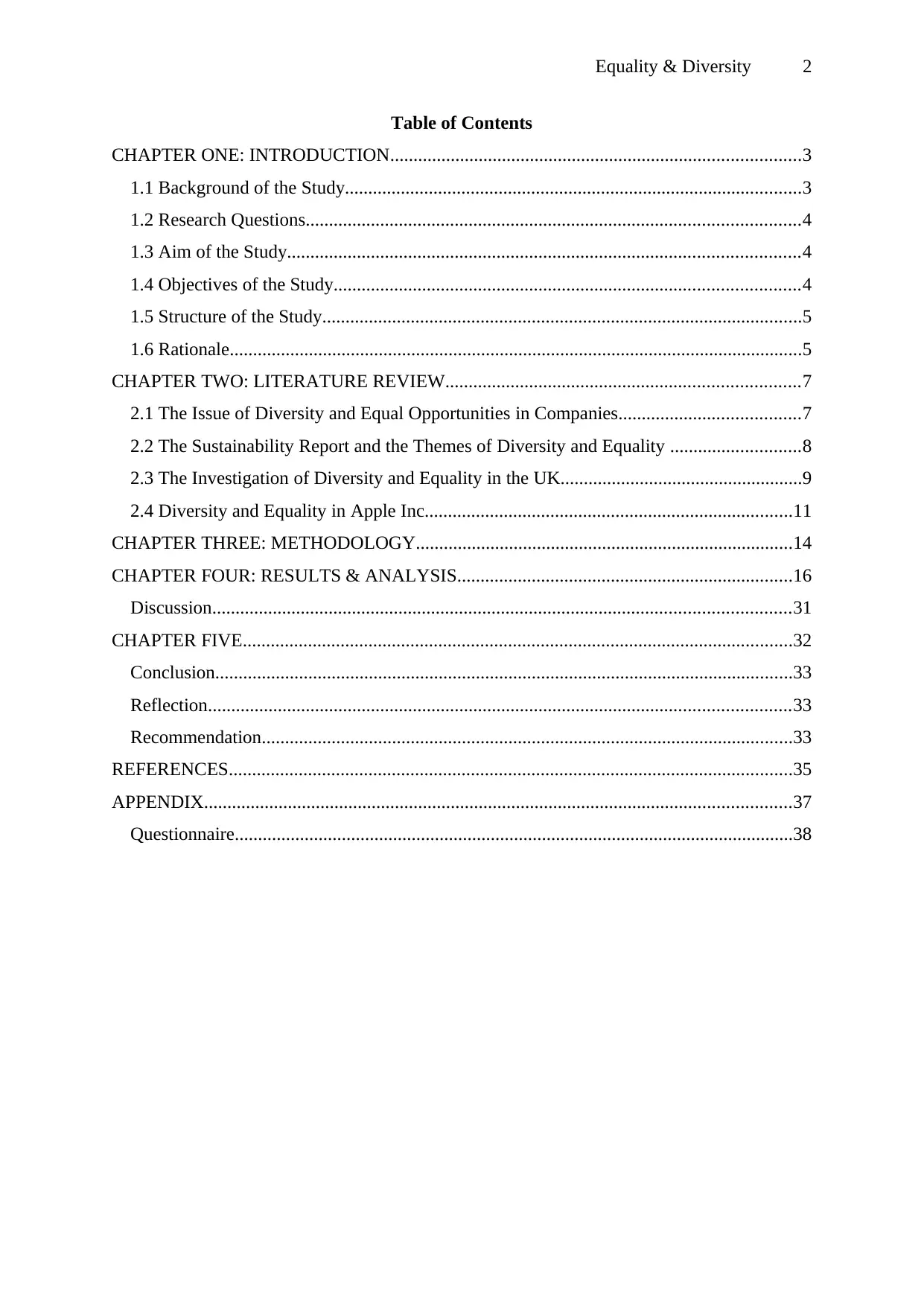
Equality & Diversity 2
Table of Contents
CHAPTER ONE: INTRODUCTION........................................................................................3
1.1 Background of the Study..................................................................................................3
1.2 Research Questions..........................................................................................................4
1.3 Aim of the Study..............................................................................................................4
1.4 Objectives of the Study....................................................................................................4
1.5 Structure of the Study.......................................................................................................5
1.6 Rationale...........................................................................................................................5
CHAPTER TWO: LITERATURE REVIEW............................................................................7
2.1 The Issue of Diversity and Equal Opportunities in Companies.......................................7
2.2 The Sustainability Report and the Themes of Diversity and Equality ............................8
2.3 The Investigation of Diversity and Equality in the UK....................................................9
2.4 Diversity and Equality in Apple Inc...............................................................................11
CHAPTER THREE: METHODOLOGY.................................................................................14
CHAPTER FOUR: RESULTS & ANALYSIS........................................................................16
Discussion............................................................................................................................31
CHAPTER FIVE......................................................................................................................32
Conclusion............................................................................................................................33
Reflection.............................................................................................................................33
Recommendation..................................................................................................................33
REFERENCES.........................................................................................................................35
APPENDIX..............................................................................................................................37
Questionnaire........................................................................................................................38
Table of Contents
CHAPTER ONE: INTRODUCTION........................................................................................3
1.1 Background of the Study..................................................................................................3
1.2 Research Questions..........................................................................................................4
1.3 Aim of the Study..............................................................................................................4
1.4 Objectives of the Study....................................................................................................4
1.5 Structure of the Study.......................................................................................................5
1.6 Rationale...........................................................................................................................5
CHAPTER TWO: LITERATURE REVIEW............................................................................7
2.1 The Issue of Diversity and Equal Opportunities in Companies.......................................7
2.2 The Sustainability Report and the Themes of Diversity and Equality ............................8
2.3 The Investigation of Diversity and Equality in the UK....................................................9
2.4 Diversity and Equality in Apple Inc...............................................................................11
CHAPTER THREE: METHODOLOGY.................................................................................14
CHAPTER FOUR: RESULTS & ANALYSIS........................................................................16
Discussion............................................................................................................................31
CHAPTER FIVE......................................................................................................................32
Conclusion............................................................................................................................33
Reflection.............................................................................................................................33
Recommendation..................................................................................................................33
REFERENCES.........................................................................................................................35
APPENDIX..............................................................................................................................37
Questionnaire........................................................................................................................38
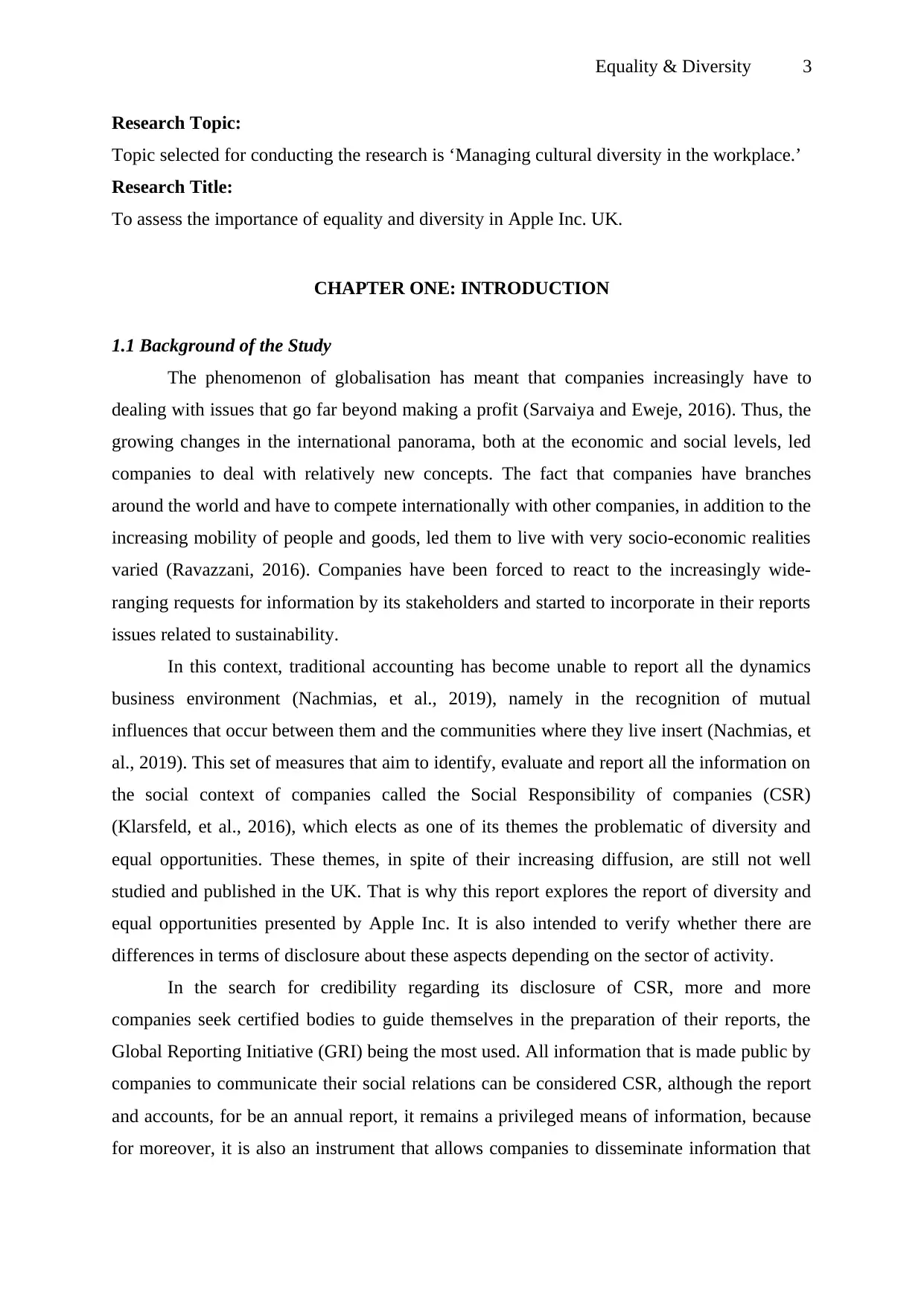
Equality & Diversity 3
Research Topic:
Topic selected for conducting the research is ‘Managing cultural diversity in the workplace.’
Research Title:
To assess the importance of equality and diversity in Apple Inc. UK.
CHAPTER ONE: INTRODUCTION
1.1 Background of the Study
The phenomenon of globalisation has meant that companies increasingly have to
dealing with issues that go far beyond making a profit (Sarvaiya and Eweje, 2016). Thus, the
growing changes in the international panorama, both at the economic and social levels, led
companies to deal with relatively new concepts. The fact that companies have branches
around the world and have to compete internationally with other companies, in addition to the
increasing mobility of people and goods, led them to live with very socio-economic realities
varied (Ravazzani, 2016). Companies have been forced to react to the increasingly wide-
ranging requests for information by its stakeholders and started to incorporate in their reports
issues related to sustainability.
In this context, traditional accounting has become unable to report all the dynamics
business environment (Nachmias, et al., 2019), namely in the recognition of mutual
influences that occur between them and the communities where they live insert (Nachmias, et
al., 2019). This set of measures that aim to identify, evaluate and report all the information on
the social context of companies called the Social Responsibility of companies (CSR)
(Klarsfeld, et al., 2016), which elects as one of its themes the problematic of diversity and
equal opportunities. These themes, in spite of their increasing diffusion, are still not well
studied and published in the UK. That is why this report explores the report of diversity and
equal opportunities presented by Apple Inc. It is also intended to verify whether there are
differences in terms of disclosure about these aspects depending on the sector of activity.
In the search for credibility regarding its disclosure of CSR, more and more
companies seek certified bodies to guide themselves in the preparation of their reports, the
Global Reporting Initiative (GRI) being the most used. All information that is made public by
companies to communicate their social relations can be considered CSR, although the report
and accounts, for be an annual report, it remains a privileged means of information, because
for moreover, it is also an instrument that allows companies to disseminate information that
Research Topic:
Topic selected for conducting the research is ‘Managing cultural diversity in the workplace.’
Research Title:
To assess the importance of equality and diversity in Apple Inc. UK.
CHAPTER ONE: INTRODUCTION
1.1 Background of the Study
The phenomenon of globalisation has meant that companies increasingly have to
dealing with issues that go far beyond making a profit (Sarvaiya and Eweje, 2016). Thus, the
growing changes in the international panorama, both at the economic and social levels, led
companies to deal with relatively new concepts. The fact that companies have branches
around the world and have to compete internationally with other companies, in addition to the
increasing mobility of people and goods, led them to live with very socio-economic realities
varied (Ravazzani, 2016). Companies have been forced to react to the increasingly wide-
ranging requests for information by its stakeholders and started to incorporate in their reports
issues related to sustainability.
In this context, traditional accounting has become unable to report all the dynamics
business environment (Nachmias, et al., 2019), namely in the recognition of mutual
influences that occur between them and the communities where they live insert (Nachmias, et
al., 2019). This set of measures that aim to identify, evaluate and report all the information on
the social context of companies called the Social Responsibility of companies (CSR)
(Klarsfeld, et al., 2016), which elects as one of its themes the problematic of diversity and
equal opportunities. These themes, in spite of their increasing diffusion, are still not well
studied and published in the UK. That is why this report explores the report of diversity and
equal opportunities presented by Apple Inc. It is also intended to verify whether there are
differences in terms of disclosure about these aspects depending on the sector of activity.
In the search for credibility regarding its disclosure of CSR, more and more
companies seek certified bodies to guide themselves in the preparation of their reports, the
Global Reporting Initiative (GRI) being the most used. All information that is made public by
companies to communicate their social relations can be considered CSR, although the report
and accounts, for be an annual report, it remains a privileged means of information, because
for moreover, it is also an instrument that allows companies to disseminate information that
⊘ This is a preview!⊘
Do you want full access?
Subscribe today to unlock all pages.

Trusted by 1+ million students worldwide
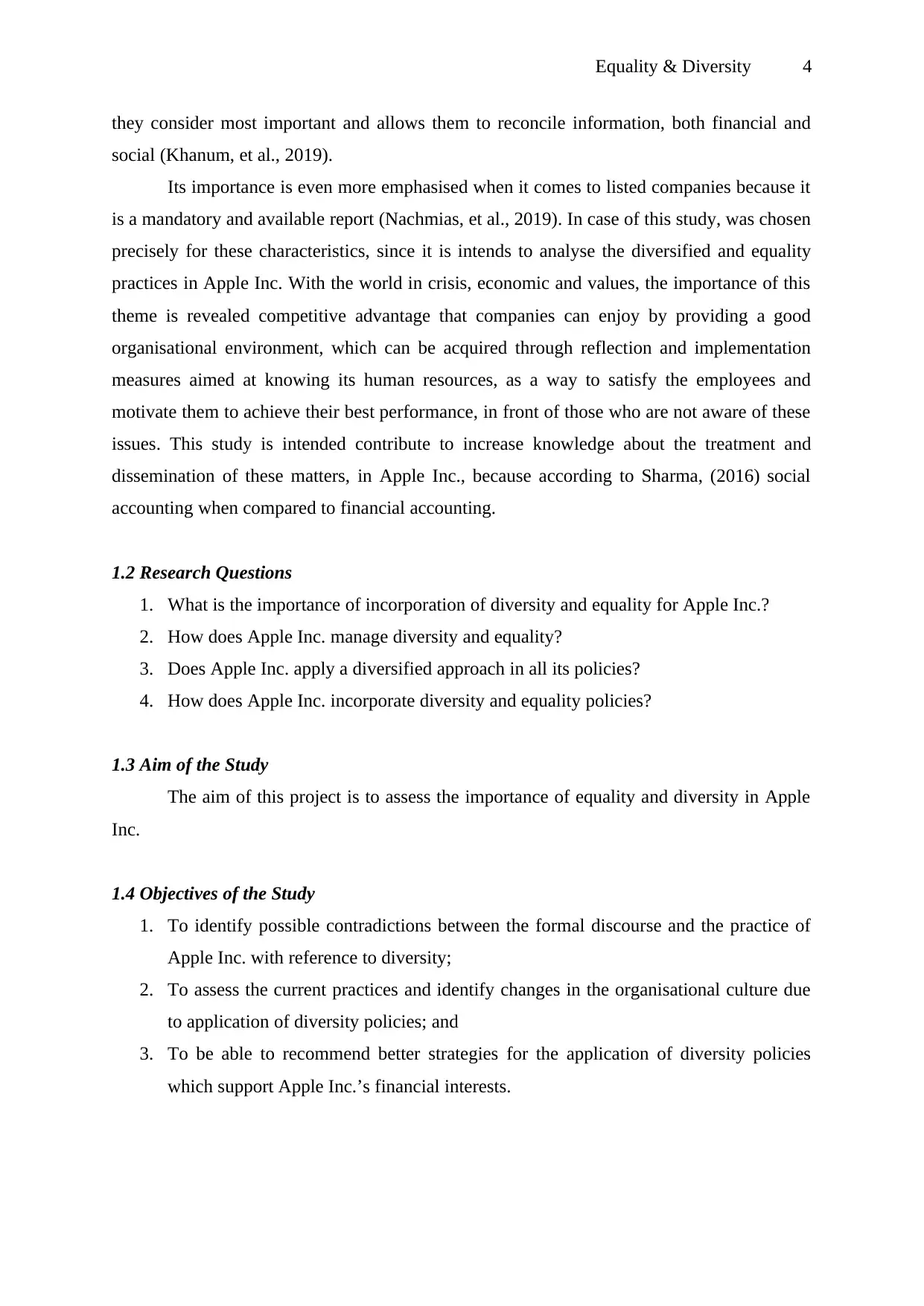
Equality & Diversity 4
they consider most important and allows them to reconcile information, both financial and
social (Khanum, et al., 2019).
Its importance is even more emphasised when it comes to listed companies because it
is a mandatory and available report (Nachmias, et al., 2019). In case of this study, was chosen
precisely for these characteristics, since it is intends to analyse the diversified and equality
practices in Apple Inc. With the world in crisis, economic and values, the importance of this
theme is revealed competitive advantage that companies can enjoy by providing a good
organisational environment, which can be acquired through reflection and implementation
measures aimed at knowing its human resources, as a way to satisfy the employees and
motivate them to achieve their best performance, in front of those who are not aware of these
issues. This study is intended contribute to increase knowledge about the treatment and
dissemination of these matters, in Apple Inc., because according to Sharma, (2016) social
accounting when compared to financial accounting.
1.2 Research Questions
1. What is the importance of incorporation of diversity and equality for Apple Inc.?
2. How does Apple Inc. manage diversity and equality?
3. Does Apple Inc. apply a diversified approach in all its policies?
4. How does Apple Inc. incorporate diversity and equality policies?
1.3 Aim of the Study
The aim of this project is to assess the importance of equality and diversity in Apple
Inc.
1.4 Objectives of the Study
1. To identify possible contradictions between the formal discourse and the practice of
Apple Inc. with reference to diversity;
2. To assess the current practices and identify changes in the organisational culture due
to application of diversity policies; and
3. To be able to recommend better strategies for the application of diversity policies
which support Apple Inc.’s financial interests.
they consider most important and allows them to reconcile information, both financial and
social (Khanum, et al., 2019).
Its importance is even more emphasised when it comes to listed companies because it
is a mandatory and available report (Nachmias, et al., 2019). In case of this study, was chosen
precisely for these characteristics, since it is intends to analyse the diversified and equality
practices in Apple Inc. With the world in crisis, economic and values, the importance of this
theme is revealed competitive advantage that companies can enjoy by providing a good
organisational environment, which can be acquired through reflection and implementation
measures aimed at knowing its human resources, as a way to satisfy the employees and
motivate them to achieve their best performance, in front of those who are not aware of these
issues. This study is intended contribute to increase knowledge about the treatment and
dissemination of these matters, in Apple Inc., because according to Sharma, (2016) social
accounting when compared to financial accounting.
1.2 Research Questions
1. What is the importance of incorporation of diversity and equality for Apple Inc.?
2. How does Apple Inc. manage diversity and equality?
3. Does Apple Inc. apply a diversified approach in all its policies?
4. How does Apple Inc. incorporate diversity and equality policies?
1.3 Aim of the Study
The aim of this project is to assess the importance of equality and diversity in Apple
Inc.
1.4 Objectives of the Study
1. To identify possible contradictions between the formal discourse and the practice of
Apple Inc. with reference to diversity;
2. To assess the current practices and identify changes in the organisational culture due
to application of diversity policies; and
3. To be able to recommend better strategies for the application of diversity policies
which support Apple Inc.’s financial interests.
Paraphrase This Document
Need a fresh take? Get an instant paraphrase of this document with our AI Paraphraser
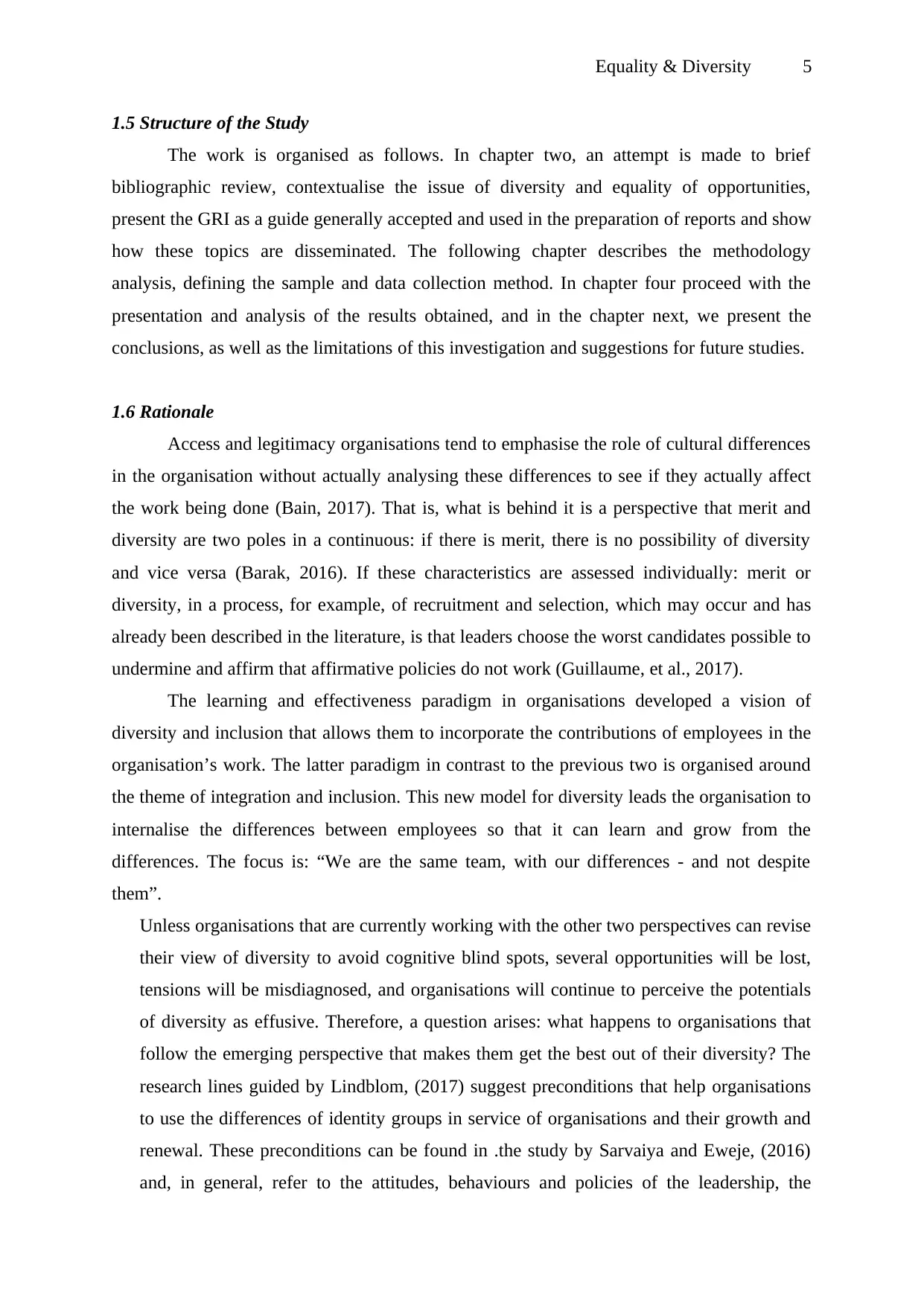
Equality & Diversity 5
1.5 Structure of the Study
The work is organised as follows. In chapter two, an attempt is made to brief
bibliographic review, contextualise the issue of diversity and equality of opportunities,
present the GRI as a guide generally accepted and used in the preparation of reports and show
how these topics are disseminated. The following chapter describes the methodology
analysis, defining the sample and data collection method. In chapter four proceed with the
presentation and analysis of the results obtained, and in the chapter next, we present the
conclusions, as well as the limitations of this investigation and suggestions for future studies.
1.6 Rationale
Access and legitimacy organisations tend to emphasise the role of cultural differences
in the organisation without actually analysing these differences to see if they actually affect
the work being done (Bain, 2017). That is, what is behind it is a perspective that merit and
diversity are two poles in a continuous: if there is merit, there is no possibility of diversity
and vice versa (Barak, 2016). If these characteristics are assessed individually: merit or
diversity, in a process, for example, of recruitment and selection, which may occur and has
already been described in the literature, is that leaders choose the worst candidates possible to
undermine and affirm that affirmative policies do not work (Guillaume, et al., 2017).
The learning and effectiveness paradigm in organisations developed a vision of
diversity and inclusion that allows them to incorporate the contributions of employees in the
organisation’s work. The latter paradigm in contrast to the previous two is organised around
the theme of integration and inclusion. This new model for diversity leads the organisation to
internalise the differences between employees so that it can learn and grow from the
differences. The focus is: “We are the same team, with our differences - and not despite
them”.
Unless organisations that are currently working with the other two perspectives can revise
their view of diversity to avoid cognitive blind spots, several opportunities will be lost,
tensions will be misdiagnosed, and organisations will continue to perceive the potentials
of diversity as effusive. Therefore, a question arises: what happens to organisations that
follow the emerging perspective that makes them get the best out of their diversity? The
research lines guided by Lindblom, (2017) suggest preconditions that help organisations
to use the differences of identity groups in service of organisations and their growth and
renewal. These preconditions can be found in .the study by Sarvaiya and Eweje, (2016)
and, in general, refer to the attitudes, behaviours and policies of the leadership, the
1.5 Structure of the Study
The work is organised as follows. In chapter two, an attempt is made to brief
bibliographic review, contextualise the issue of diversity and equality of opportunities,
present the GRI as a guide generally accepted and used in the preparation of reports and show
how these topics are disseminated. The following chapter describes the methodology
analysis, defining the sample and data collection method. In chapter four proceed with the
presentation and analysis of the results obtained, and in the chapter next, we present the
conclusions, as well as the limitations of this investigation and suggestions for future studies.
1.6 Rationale
Access and legitimacy organisations tend to emphasise the role of cultural differences
in the organisation without actually analysing these differences to see if they actually affect
the work being done (Bain, 2017). That is, what is behind it is a perspective that merit and
diversity are two poles in a continuous: if there is merit, there is no possibility of diversity
and vice versa (Barak, 2016). If these characteristics are assessed individually: merit or
diversity, in a process, for example, of recruitment and selection, which may occur and has
already been described in the literature, is that leaders choose the worst candidates possible to
undermine and affirm that affirmative policies do not work (Guillaume, et al., 2017).
The learning and effectiveness paradigm in organisations developed a vision of
diversity and inclusion that allows them to incorporate the contributions of employees in the
organisation’s work. The latter paradigm in contrast to the previous two is organised around
the theme of integration and inclusion. This new model for diversity leads the organisation to
internalise the differences between employees so that it can learn and grow from the
differences. The focus is: “We are the same team, with our differences - and not despite
them”.
Unless organisations that are currently working with the other two perspectives can revise
their view of diversity to avoid cognitive blind spots, several opportunities will be lost,
tensions will be misdiagnosed, and organisations will continue to perceive the potentials
of diversity as effusive. Therefore, a question arises: what happens to organisations that
follow the emerging perspective that makes them get the best out of their diversity? The
research lines guided by Lindblom, (2017) suggest preconditions that help organisations
to use the differences of identity groups in service of organisations and their growth and
renewal. These preconditions can be found in .the study by Sarvaiya and Eweje, (2016)
and, in general, refer to the attitudes, behaviours and policies of the leadership, the
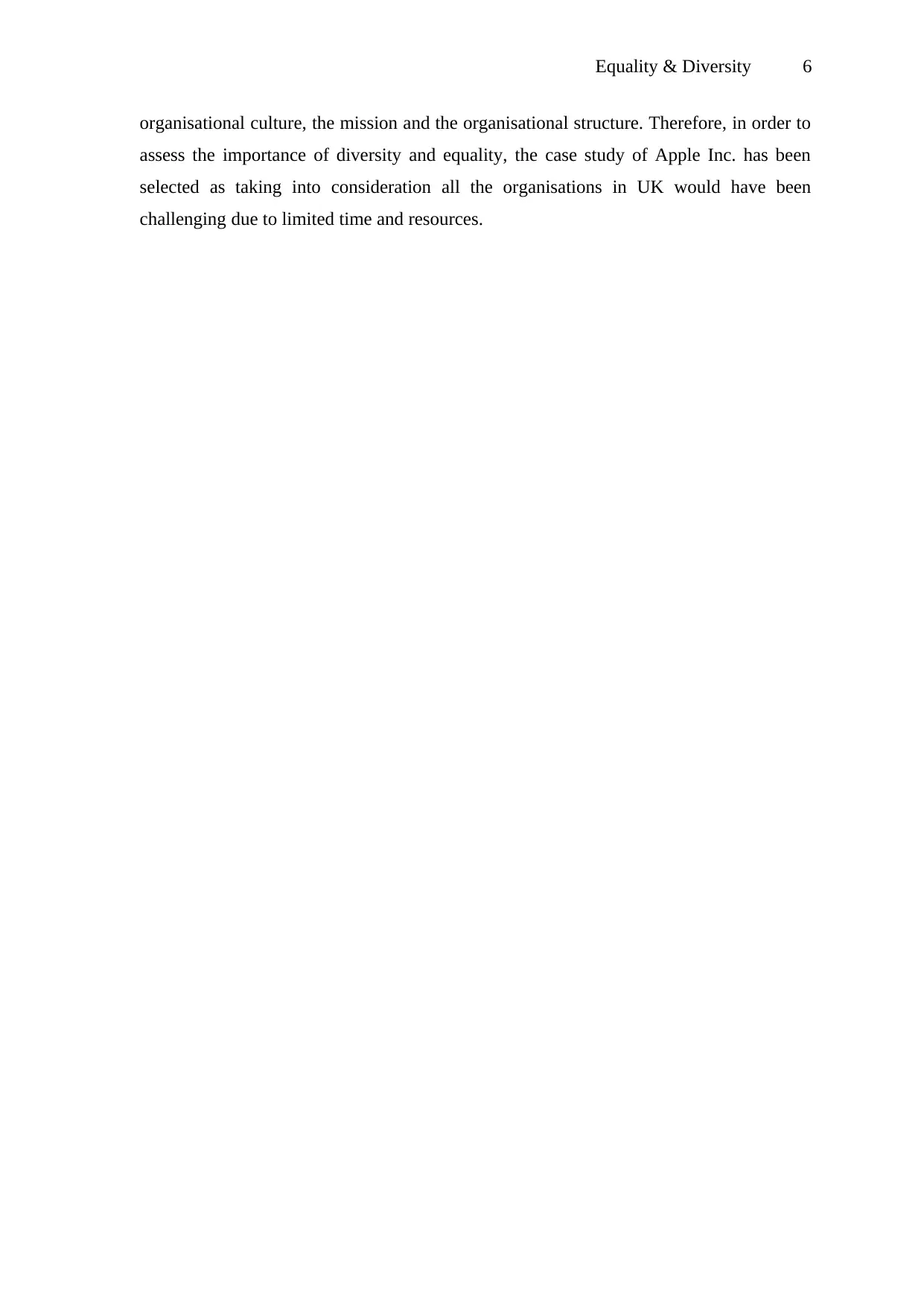
Equality & Diversity 6
organisational culture, the mission and the organisational structure. Therefore, in order to
assess the importance of diversity and equality, the case study of Apple Inc. has been
selected as taking into consideration all the organisations in UK would have been
challenging due to limited time and resources.
organisational culture, the mission and the organisational structure. Therefore, in order to
assess the importance of diversity and equality, the case study of Apple Inc. has been
selected as taking into consideration all the organisations in UK would have been
challenging due to limited time and resources.
⊘ This is a preview!⊘
Do you want full access?
Subscribe today to unlock all pages.

Trusted by 1+ million students worldwide
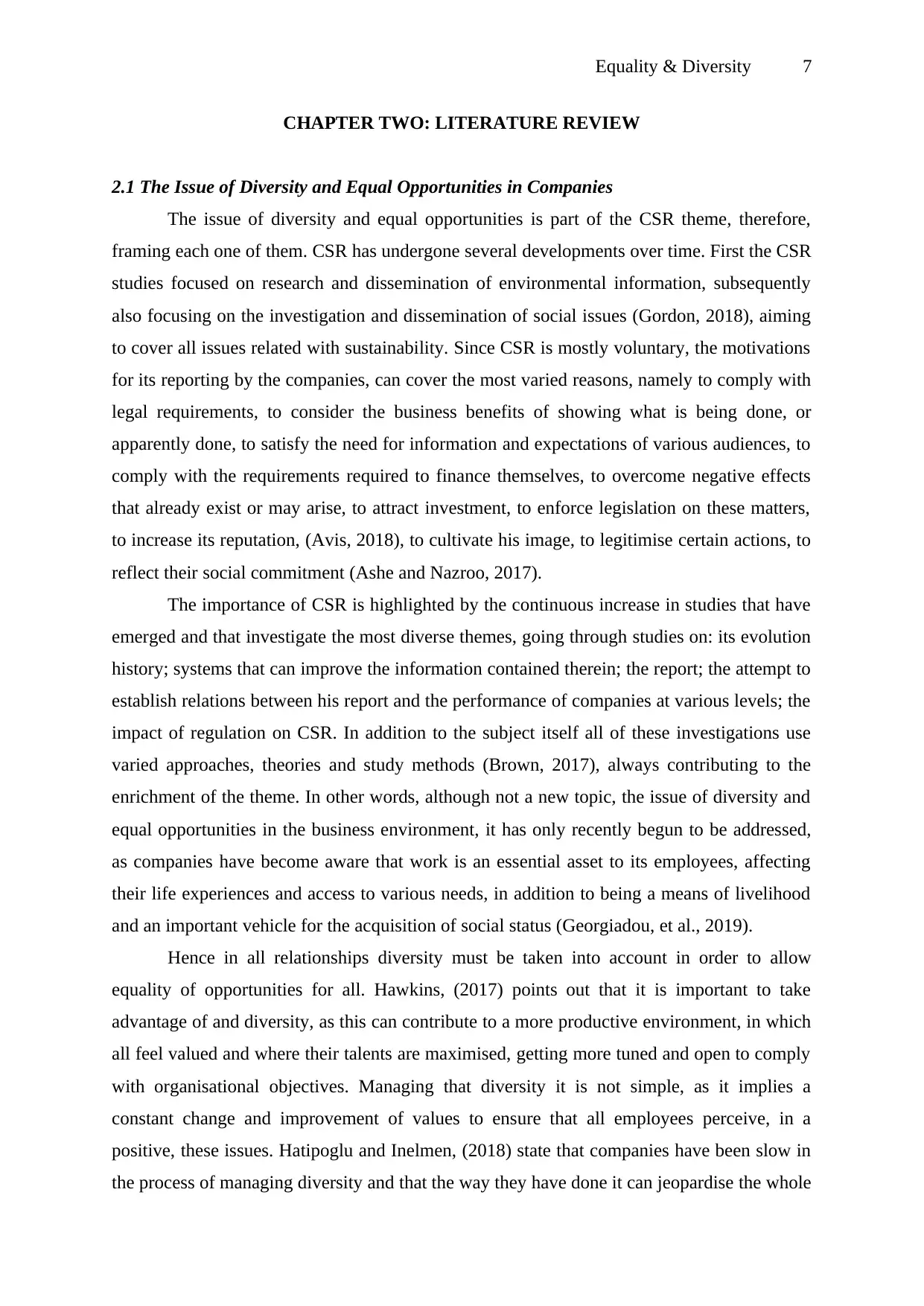
Equality & Diversity 7
CHAPTER TWO: LITERATURE REVIEW
2.1 The Issue of Diversity and Equal Opportunities in Companies
The issue of diversity and equal opportunities is part of the CSR theme, therefore,
framing each one of them. CSR has undergone several developments over time. First the CSR
studies focused on research and dissemination of environmental information, subsequently
also focusing on the investigation and dissemination of social issues (Gordon, 2018), aiming
to cover all issues related with sustainability. Since CSR is mostly voluntary, the motivations
for its reporting by the companies, can cover the most varied reasons, namely to comply with
legal requirements, to consider the business benefits of showing what is being done, or
apparently done, to satisfy the need for information and expectations of various audiences, to
comply with the requirements required to finance themselves, to overcome negative effects
that already exist or may arise, to attract investment, to enforce legislation on these matters,
to increase its reputation, (Avis, 2018), to cultivate his image, to legitimise certain actions, to
reflect their social commitment (Ashe and Nazroo, 2017).
The importance of CSR is highlighted by the continuous increase in studies that have
emerged and that investigate the most diverse themes, going through studies on: its evolution
history; systems that can improve the information contained therein; the report; the attempt to
establish relations between his report and the performance of companies at various levels; the
impact of regulation on CSR. In addition to the subject itself all of these investigations use
varied approaches, theories and study methods (Brown, 2017), always contributing to the
enrichment of the theme. In other words, although not a new topic, the issue of diversity and
equal opportunities in the business environment, it has only recently begun to be addressed,
as companies have become aware that work is an essential asset to its employees, affecting
their life experiences and access to various needs, in addition to being a means of livelihood
and an important vehicle for the acquisition of social status (Georgiadou, et al., 2019).
Hence in all relationships diversity must be taken into account in order to allow
equality of opportunities for all. Hawkins, (2017) points out that it is important to take
advantage of and diversity, as this can contribute to a more productive environment, in which
all feel valued and where their talents are maximised, getting more tuned and open to comply
with organisational objectives. Managing that diversity it is not simple, as it implies a
constant change and improvement of values to ensure that all employees perceive, in a
positive, these issues. Hatipoglu and Inelmen, (2018) state that companies have been slow in
the process of managing diversity and that the way they have done it can jeopardise the whole
CHAPTER TWO: LITERATURE REVIEW
2.1 The Issue of Diversity and Equal Opportunities in Companies
The issue of diversity and equal opportunities is part of the CSR theme, therefore,
framing each one of them. CSR has undergone several developments over time. First the CSR
studies focused on research and dissemination of environmental information, subsequently
also focusing on the investigation and dissemination of social issues (Gordon, 2018), aiming
to cover all issues related with sustainability. Since CSR is mostly voluntary, the motivations
for its reporting by the companies, can cover the most varied reasons, namely to comply with
legal requirements, to consider the business benefits of showing what is being done, or
apparently done, to satisfy the need for information and expectations of various audiences, to
comply with the requirements required to finance themselves, to overcome negative effects
that already exist or may arise, to attract investment, to enforce legislation on these matters,
to increase its reputation, (Avis, 2018), to cultivate his image, to legitimise certain actions, to
reflect their social commitment (Ashe and Nazroo, 2017).
The importance of CSR is highlighted by the continuous increase in studies that have
emerged and that investigate the most diverse themes, going through studies on: its evolution
history; systems that can improve the information contained therein; the report; the attempt to
establish relations between his report and the performance of companies at various levels; the
impact of regulation on CSR. In addition to the subject itself all of these investigations use
varied approaches, theories and study methods (Brown, 2017), always contributing to the
enrichment of the theme. In other words, although not a new topic, the issue of diversity and
equal opportunities in the business environment, it has only recently begun to be addressed,
as companies have become aware that work is an essential asset to its employees, affecting
their life experiences and access to various needs, in addition to being a means of livelihood
and an important vehicle for the acquisition of social status (Georgiadou, et al., 2019).
Hence in all relationships diversity must be taken into account in order to allow
equality of opportunities for all. Hawkins, (2017) points out that it is important to take
advantage of and diversity, as this can contribute to a more productive environment, in which
all feel valued and where their talents are maximised, getting more tuned and open to comply
with organisational objectives. Managing that diversity it is not simple, as it implies a
constant change and improvement of values to ensure that all employees perceive, in a
positive, these issues. Hatipoglu and Inelmen, (2018) state that companies have been slow in
the process of managing diversity and that the way they have done it can jeopardise the whole
Paraphrase This Document
Need a fresh take? Get an instant paraphrase of this document with our AI Paraphraser
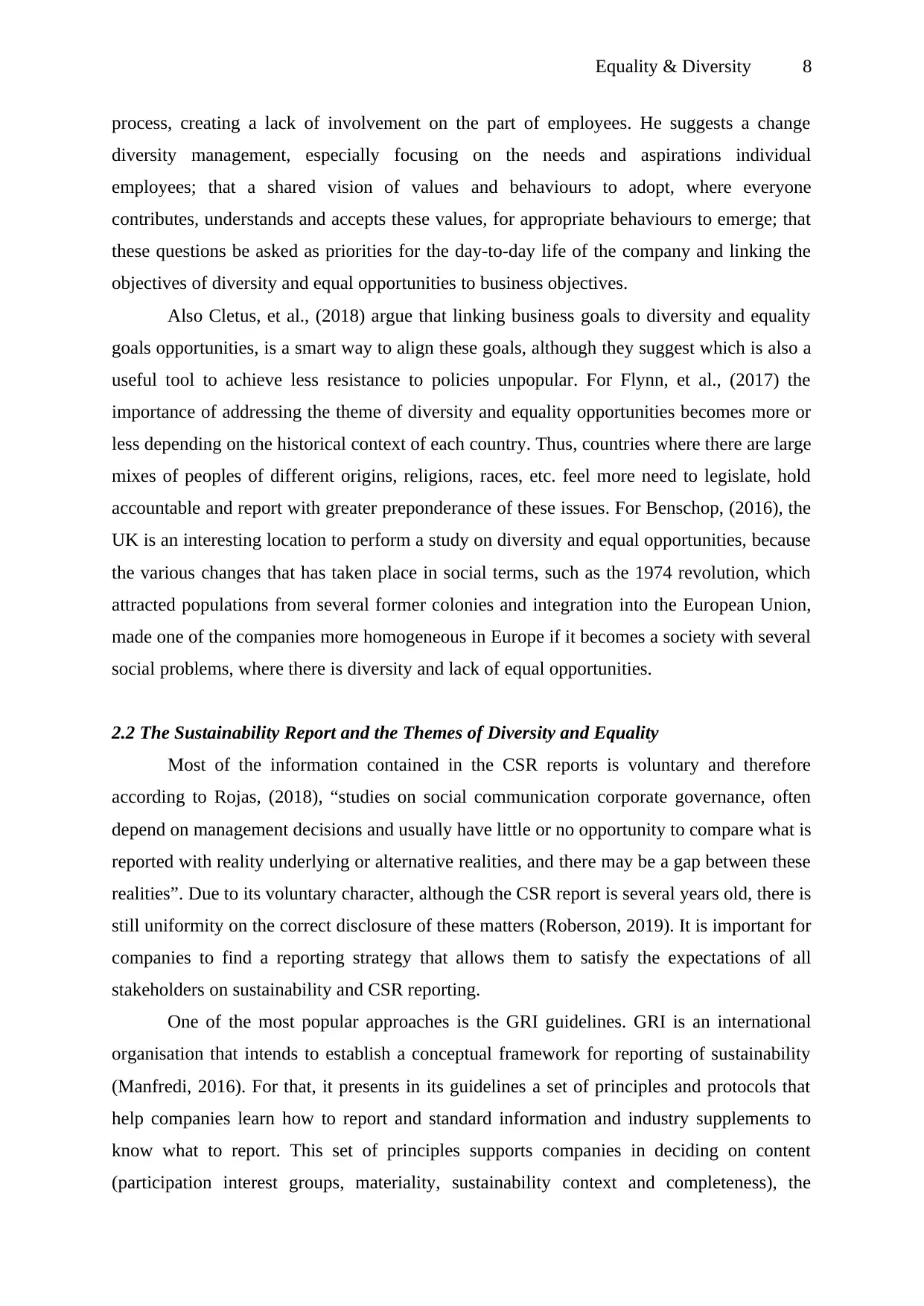
Equality & Diversity 8
process, creating a lack of involvement on the part of employees. He suggests a change
diversity management, especially focusing on the needs and aspirations individual
employees; that a shared vision of values and behaviours to adopt, where everyone
contributes, understands and accepts these values, for appropriate behaviours to emerge; that
these questions be asked as priorities for the day-to-day life of the company and linking the
objectives of diversity and equal opportunities to business objectives.
Also Cletus, et al., (2018) argue that linking business goals to diversity and equality
goals opportunities, is a smart way to align these goals, although they suggest which is also a
useful tool to achieve less resistance to policies unpopular. For Flynn, et al., (2017) the
importance of addressing the theme of diversity and equality opportunities becomes more or
less depending on the historical context of each country. Thus, countries where there are large
mixes of peoples of different origins, religions, races, etc. feel more need to legislate, hold
accountable and report with greater preponderance of these issues. For Benschop, (2016), the
UK is an interesting location to perform a study on diversity and equal opportunities, because
the various changes that has taken place in social terms, such as the 1974 revolution, which
attracted populations from several former colonies and integration into the European Union,
made one of the companies more homogeneous in Europe if it becomes a society with several
social problems, where there is diversity and lack of equal opportunities.
2.2 The Sustainability Report and the Themes of Diversity and Equality
Most of the information contained in the CSR reports is voluntary and therefore
according to Rojas, (2018), “studies on social communication corporate governance, often
depend on management decisions and usually have little or no opportunity to compare what is
reported with reality underlying or alternative realities, and there may be a gap between these
realities”. Due to its voluntary character, although the CSR report is several years old, there is
still uniformity on the correct disclosure of these matters (Roberson, 2019). It is important for
companies to find a reporting strategy that allows them to satisfy the expectations of all
stakeholders on sustainability and CSR reporting.
One of the most popular approaches is the GRI guidelines. GRI is an international
organisation that intends to establish a conceptual framework for reporting of sustainability
(Manfredi, 2016). For that, it presents in its guidelines a set of principles and protocols that
help companies learn how to report and standard information and industry supplements to
know what to report. This set of principles supports companies in deciding on content
(participation interest groups, materiality, sustainability context and completeness), the
process, creating a lack of involvement on the part of employees. He suggests a change
diversity management, especially focusing on the needs and aspirations individual
employees; that a shared vision of values and behaviours to adopt, where everyone
contributes, understands and accepts these values, for appropriate behaviours to emerge; that
these questions be asked as priorities for the day-to-day life of the company and linking the
objectives of diversity and equal opportunities to business objectives.
Also Cletus, et al., (2018) argue that linking business goals to diversity and equality
goals opportunities, is a smart way to align these goals, although they suggest which is also a
useful tool to achieve less resistance to policies unpopular. For Flynn, et al., (2017) the
importance of addressing the theme of diversity and equality opportunities becomes more or
less depending on the historical context of each country. Thus, countries where there are large
mixes of peoples of different origins, religions, races, etc. feel more need to legislate, hold
accountable and report with greater preponderance of these issues. For Benschop, (2016), the
UK is an interesting location to perform a study on diversity and equal opportunities, because
the various changes that has taken place in social terms, such as the 1974 revolution, which
attracted populations from several former colonies and integration into the European Union,
made one of the companies more homogeneous in Europe if it becomes a society with several
social problems, where there is diversity and lack of equal opportunities.
2.2 The Sustainability Report and the Themes of Diversity and Equality
Most of the information contained in the CSR reports is voluntary and therefore
according to Rojas, (2018), “studies on social communication corporate governance, often
depend on management decisions and usually have little or no opportunity to compare what is
reported with reality underlying or alternative realities, and there may be a gap between these
realities”. Due to its voluntary character, although the CSR report is several years old, there is
still uniformity on the correct disclosure of these matters (Roberson, 2019). It is important for
companies to find a reporting strategy that allows them to satisfy the expectations of all
stakeholders on sustainability and CSR reporting.
One of the most popular approaches is the GRI guidelines. GRI is an international
organisation that intends to establish a conceptual framework for reporting of sustainability
(Manfredi, 2016). For that, it presents in its guidelines a set of principles and protocols that
help companies learn how to report and standard information and industry supplements to
know what to report. This set of principles supports companies in deciding on content
(participation interest groups, materiality, sustainability context and completeness), the
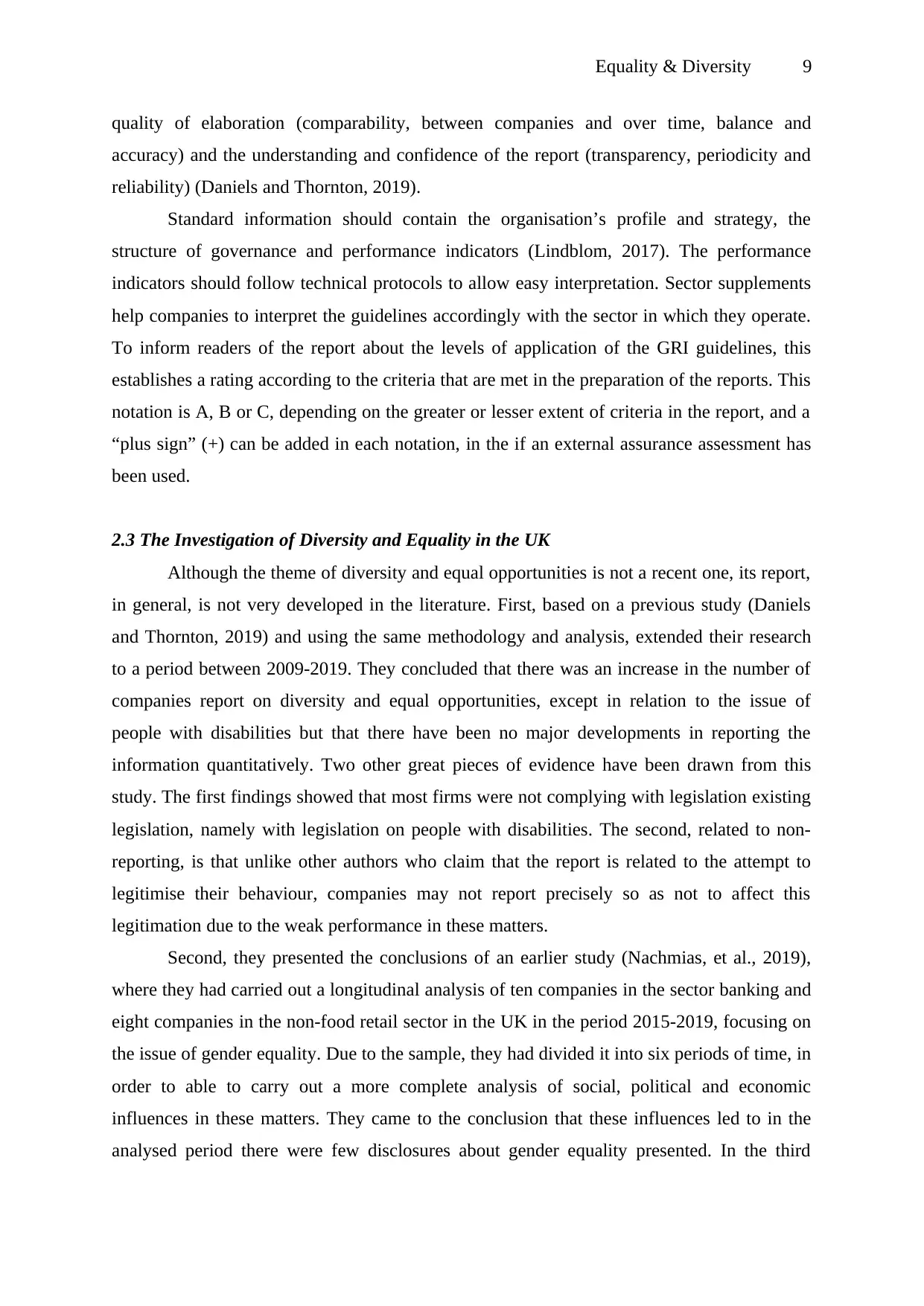
Equality & Diversity 9
quality of elaboration (comparability, between companies and over time, balance and
accuracy) and the understanding and confidence of the report (transparency, periodicity and
reliability) (Daniels and Thornton, 2019).
Standard information should contain the organisation’s profile and strategy, the
structure of governance and performance indicators (Lindblom, 2017). The performance
indicators should follow technical protocols to allow easy interpretation. Sector supplements
help companies to interpret the guidelines accordingly with the sector in which they operate.
To inform readers of the report about the levels of application of the GRI guidelines, this
establishes a rating according to the criteria that are met in the preparation of the reports. This
notation is A, B or C, depending on the greater or lesser extent of criteria in the report, and a
“plus sign” (+) can be added in each notation, in the if an external assurance assessment has
been used.
2.3 The Investigation of Diversity and Equality in the UK
Although the theme of diversity and equal opportunities is not a recent one, its report,
in general, is not very developed in the literature. First, based on a previous study (Daniels
and Thornton, 2019) and using the same methodology and analysis, extended their research
to a period between 2009-2019. They concluded that there was an increase in the number of
companies report on diversity and equal opportunities, except in relation to the issue of
people with disabilities but that there have been no major developments in reporting the
information quantitatively. Two other great pieces of evidence have been drawn from this
study. The first findings showed that most firms were not complying with legislation existing
legislation, namely with legislation on people with disabilities. The second, related to non-
reporting, is that unlike other authors who claim that the report is related to the attempt to
legitimise their behaviour, companies may not report precisely so as not to affect this
legitimation due to the weak performance in these matters.
Second, they presented the conclusions of an earlier study (Nachmias, et al., 2019),
where they had carried out a longitudinal analysis of ten companies in the sector banking and
eight companies in the non-food retail sector in the UK in the period 2015-2019, focusing on
the issue of gender equality. Due to the sample, they had divided it into six periods of time, in
order to able to carry out a more complete analysis of social, political and economic
influences in these matters. They came to the conclusion that these influences led to in the
analysed period there were few disclosures about gender equality presented. In the third
quality of elaboration (comparability, between companies and over time, balance and
accuracy) and the understanding and confidence of the report (transparency, periodicity and
reliability) (Daniels and Thornton, 2019).
Standard information should contain the organisation’s profile and strategy, the
structure of governance and performance indicators (Lindblom, 2017). The performance
indicators should follow technical protocols to allow easy interpretation. Sector supplements
help companies to interpret the guidelines accordingly with the sector in which they operate.
To inform readers of the report about the levels of application of the GRI guidelines, this
establishes a rating according to the criteria that are met in the preparation of the reports. This
notation is A, B or C, depending on the greater or lesser extent of criteria in the report, and a
“plus sign” (+) can be added in each notation, in the if an external assurance assessment has
been used.
2.3 The Investigation of Diversity and Equality in the UK
Although the theme of diversity and equal opportunities is not a recent one, its report,
in general, is not very developed in the literature. First, based on a previous study (Daniels
and Thornton, 2019) and using the same methodology and analysis, extended their research
to a period between 2009-2019. They concluded that there was an increase in the number of
companies report on diversity and equal opportunities, except in relation to the issue of
people with disabilities but that there have been no major developments in reporting the
information quantitatively. Two other great pieces of evidence have been drawn from this
study. The first findings showed that most firms were not complying with legislation existing
legislation, namely with legislation on people with disabilities. The second, related to non-
reporting, is that unlike other authors who claim that the report is related to the attempt to
legitimise their behaviour, companies may not report precisely so as not to affect this
legitimation due to the weak performance in these matters.
Second, they presented the conclusions of an earlier study (Nachmias, et al., 2019),
where they had carried out a longitudinal analysis of ten companies in the sector banking and
eight companies in the non-food retail sector in the UK in the period 2015-2019, focusing on
the issue of gender equality. Due to the sample, they had divided it into six periods of time, in
order to able to carry out a more complete analysis of social, political and economic
influences in these matters. They came to the conclusion that these influences led to in the
analysed period there were few disclosures about gender equality presented. In the third
⊘ This is a preview!⊘
Do you want full access?
Subscribe today to unlock all pages.

Trusted by 1+ million students worldwide
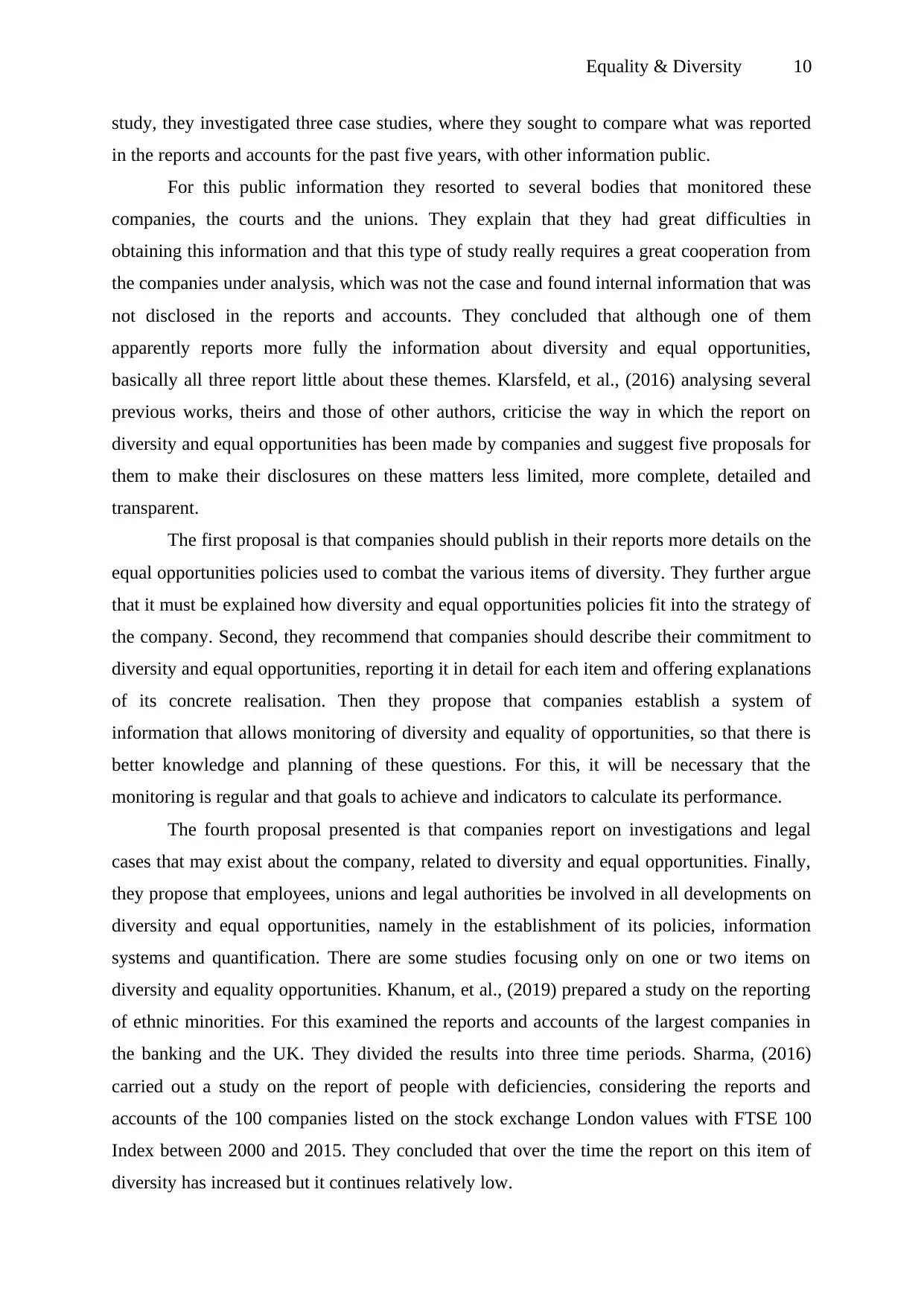
Equality & Diversity 10
study, they investigated three case studies, where they sought to compare what was reported
in the reports and accounts for the past five years, with other information public.
For this public information they resorted to several bodies that monitored these
companies, the courts and the unions. They explain that they had great difficulties in
obtaining this information and that this type of study really requires a great cooperation from
the companies under analysis, which was not the case and found internal information that was
not disclosed in the reports and accounts. They concluded that although one of them
apparently reports more fully the information about diversity and equal opportunities,
basically all three report little about these themes. Klarsfeld, et al., (2016) analysing several
previous works, theirs and those of other authors, criticise the way in which the report on
diversity and equal opportunities has been made by companies and suggest five proposals for
them to make their disclosures on these matters less limited, more complete, detailed and
transparent.
The first proposal is that companies should publish in their reports more details on the
equal opportunities policies used to combat the various items of diversity. They further argue
that it must be explained how diversity and equal opportunities policies fit into the strategy of
the company. Second, they recommend that companies should describe their commitment to
diversity and equal opportunities, reporting it in detail for each item and offering explanations
of its concrete realisation. Then they propose that companies establish a system of
information that allows monitoring of diversity and equality of opportunities, so that there is
better knowledge and planning of these questions. For this, it will be necessary that the
monitoring is regular and that goals to achieve and indicators to calculate its performance.
The fourth proposal presented is that companies report on investigations and legal
cases that may exist about the company, related to diversity and equal opportunities. Finally,
they propose that employees, unions and legal authorities be involved in all developments on
diversity and equal opportunities, namely in the establishment of its policies, information
systems and quantification. There are some studies focusing only on one or two items on
diversity and equality opportunities. Khanum, et al., (2019) prepared a study on the reporting
of ethnic minorities. For this examined the reports and accounts of the largest companies in
the banking and the UK. They divided the results into three time periods. Sharma, (2016)
carried out a study on the report of people with deficiencies, considering the reports and
accounts of the 100 companies listed on the stock exchange London values with FTSE 100
Index between 2000 and 2015. They concluded that over the time the report on this item of
diversity has increased but it continues relatively low.
study, they investigated three case studies, where they sought to compare what was reported
in the reports and accounts for the past five years, with other information public.
For this public information they resorted to several bodies that monitored these
companies, the courts and the unions. They explain that they had great difficulties in
obtaining this information and that this type of study really requires a great cooperation from
the companies under analysis, which was not the case and found internal information that was
not disclosed in the reports and accounts. They concluded that although one of them
apparently reports more fully the information about diversity and equal opportunities,
basically all three report little about these themes. Klarsfeld, et al., (2016) analysing several
previous works, theirs and those of other authors, criticise the way in which the report on
diversity and equal opportunities has been made by companies and suggest five proposals for
them to make their disclosures on these matters less limited, more complete, detailed and
transparent.
The first proposal is that companies should publish in their reports more details on the
equal opportunities policies used to combat the various items of diversity. They further argue
that it must be explained how diversity and equal opportunities policies fit into the strategy of
the company. Second, they recommend that companies should describe their commitment to
diversity and equal opportunities, reporting it in detail for each item and offering explanations
of its concrete realisation. Then they propose that companies establish a system of
information that allows monitoring of diversity and equality of opportunities, so that there is
better knowledge and planning of these questions. For this, it will be necessary that the
monitoring is regular and that goals to achieve and indicators to calculate its performance.
The fourth proposal presented is that companies report on investigations and legal
cases that may exist about the company, related to diversity and equal opportunities. Finally,
they propose that employees, unions and legal authorities be involved in all developments on
diversity and equal opportunities, namely in the establishment of its policies, information
systems and quantification. There are some studies focusing only on one or two items on
diversity and equality opportunities. Khanum, et al., (2019) prepared a study on the reporting
of ethnic minorities. For this examined the reports and accounts of the largest companies in
the banking and the UK. They divided the results into three time periods. Sharma, (2016)
carried out a study on the report of people with deficiencies, considering the reports and
accounts of the 100 companies listed on the stock exchange London values with FTSE 100
Index between 2000 and 2015. They concluded that over the time the report on this item of
diversity has increased but it continues relatively low.
Paraphrase This Document
Need a fresh take? Get an instant paraphrase of this document with our AI Paraphraser
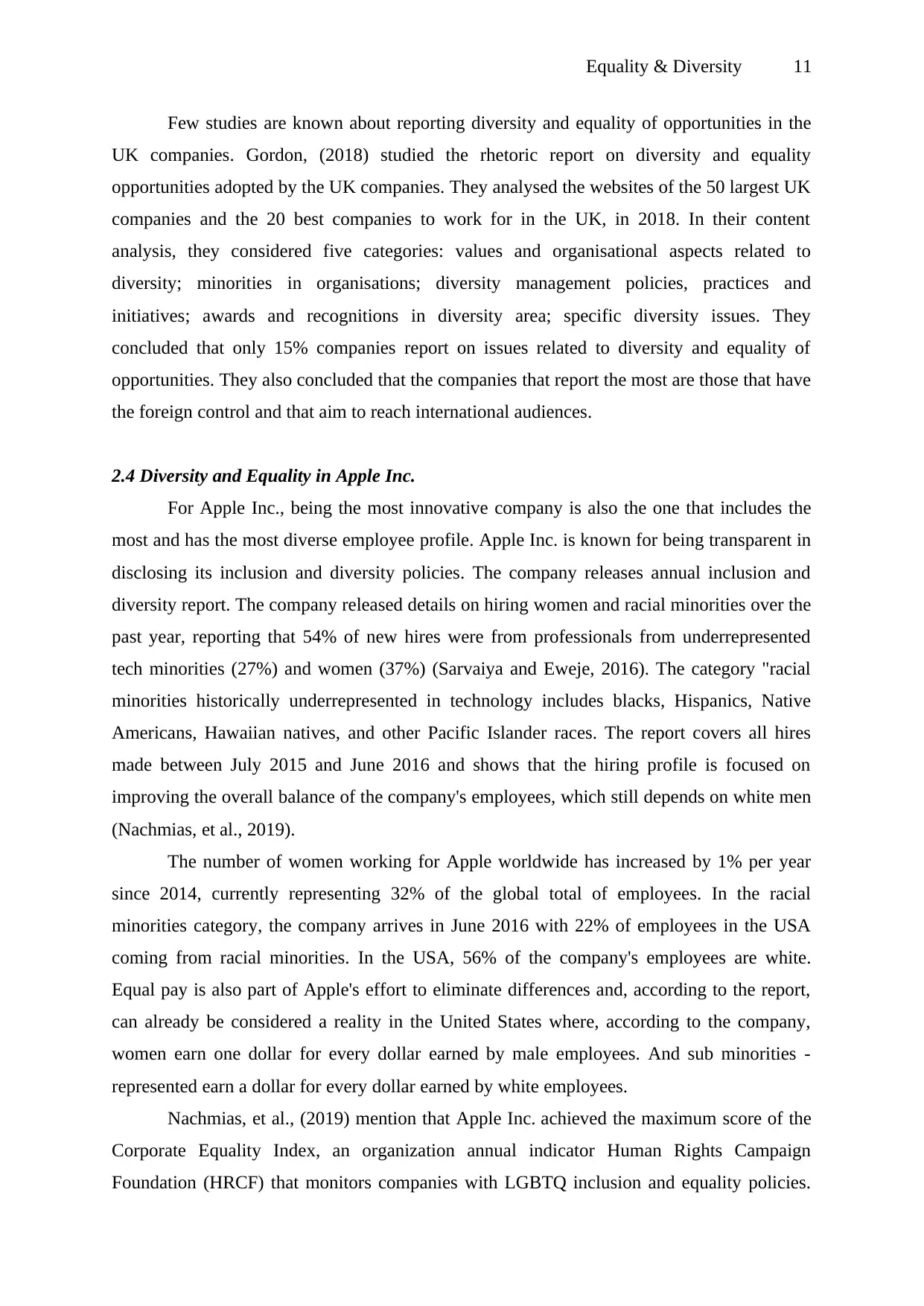
Equality & Diversity 11
Few studies are known about reporting diversity and equality of opportunities in the
UK companies. Gordon, (2018) studied the rhetoric report on diversity and equality
opportunities adopted by the UK companies. They analysed the websites of the 50 largest UK
companies and the 20 best companies to work for in the UK, in 2018. In their content
analysis, they considered five categories: values and organisational aspects related to
diversity; minorities in organisations; diversity management policies, practices and
initiatives; awards and recognitions in diversity area; specific diversity issues. They
concluded that only 15% companies report on issues related to diversity and equality of
opportunities. They also concluded that the companies that report the most are those that have
the foreign control and that aim to reach international audiences.
2.4 Diversity and Equality in Apple Inc.
For Apple Inc., being the most innovative company is also the one that includes the
most and has the most diverse employee profile. Apple Inc. is known for being transparent in
disclosing its inclusion and diversity policies. The company releases annual inclusion and
diversity report. The company released details on hiring women and racial minorities over the
past year, reporting that 54% of new hires were from professionals from underrepresented
tech minorities (27%) and women (37%) (Sarvaiya and Eweje, 2016). The category "racial
minorities historically underrepresented in technology includes blacks, Hispanics, Native
Americans, Hawaiian natives, and other Pacific Islander races. The report covers all hires
made between July 2015 and June 2016 and shows that the hiring profile is focused on
improving the overall balance of the company's employees, which still depends on white men
(Nachmias, et al., 2019).
The number of women working for Apple worldwide has increased by 1% per year
since 2014, currently representing 32% of the global total of employees. In the racial
minorities category, the company arrives in June 2016 with 22% of employees in the USA
coming from racial minorities. In the USA, 56% of the company's employees are white.
Equal pay is also part of Apple's effort to eliminate differences and, according to the report,
can already be considered a reality in the United States where, according to the company,
women earn one dollar for every dollar earned by male employees. And sub minorities -
represented earn a dollar for every dollar earned by white employees.
Nachmias, et al., (2019) mention that Apple Inc. achieved the maximum score of the
Corporate Equality Index, an organization annual indicator Human Rights Campaign
Foundation (HRCF) that monitors companies with LGBTQ inclusion and equality policies.
Few studies are known about reporting diversity and equality of opportunities in the
UK companies. Gordon, (2018) studied the rhetoric report on diversity and equality
opportunities adopted by the UK companies. They analysed the websites of the 50 largest UK
companies and the 20 best companies to work for in the UK, in 2018. In their content
analysis, they considered five categories: values and organisational aspects related to
diversity; minorities in organisations; diversity management policies, practices and
initiatives; awards and recognitions in diversity area; specific diversity issues. They
concluded that only 15% companies report on issues related to diversity and equality of
opportunities. They also concluded that the companies that report the most are those that have
the foreign control and that aim to reach international audiences.
2.4 Diversity and Equality in Apple Inc.
For Apple Inc., being the most innovative company is also the one that includes the
most and has the most diverse employee profile. Apple Inc. is known for being transparent in
disclosing its inclusion and diversity policies. The company releases annual inclusion and
diversity report. The company released details on hiring women and racial minorities over the
past year, reporting that 54% of new hires were from professionals from underrepresented
tech minorities (27%) and women (37%) (Sarvaiya and Eweje, 2016). The category "racial
minorities historically underrepresented in technology includes blacks, Hispanics, Native
Americans, Hawaiian natives, and other Pacific Islander races. The report covers all hires
made between July 2015 and June 2016 and shows that the hiring profile is focused on
improving the overall balance of the company's employees, which still depends on white men
(Nachmias, et al., 2019).
The number of women working for Apple worldwide has increased by 1% per year
since 2014, currently representing 32% of the global total of employees. In the racial
minorities category, the company arrives in June 2016 with 22% of employees in the USA
coming from racial minorities. In the USA, 56% of the company's employees are white.
Equal pay is also part of Apple's effort to eliminate differences and, according to the report,
can already be considered a reality in the United States where, according to the company,
women earn one dollar for every dollar earned by male employees. And sub minorities -
represented earn a dollar for every dollar earned by white employees.
Nachmias, et al., (2019) mention that Apple Inc. achieved the maximum score of the
Corporate Equality Index, an organization annual indicator Human Rights Campaign
Foundation (HRCF) that monitors companies with LGBTQ inclusion and equality policies.
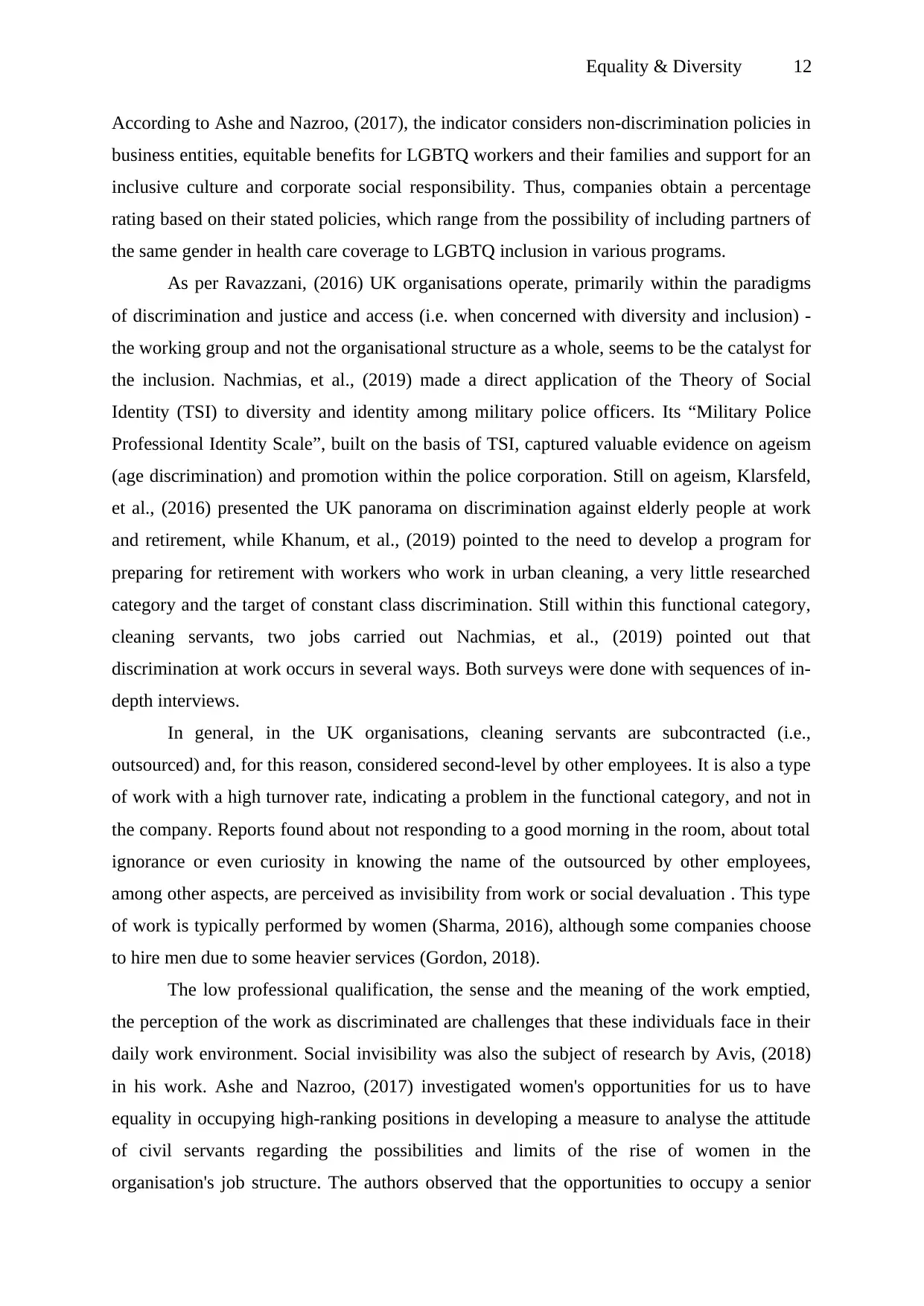
Equality & Diversity 12
According to Ashe and Nazroo, (2017), the indicator considers non-discrimination policies in
business entities, equitable benefits for LGBTQ workers and their families and support for an
inclusive culture and corporate social responsibility. Thus, companies obtain a percentage
rating based on their stated policies, which range from the possibility of including partners of
the same gender in health care coverage to LGBTQ inclusion in various programs.
As per Ravazzani, (2016) UK organisations operate, primarily within the paradigms
of discrimination and justice and access (i.e. when concerned with diversity and inclusion) -
the working group and not the organisational structure as a whole, seems to be the catalyst for
the inclusion. Nachmias, et al., (2019) made a direct application of the Theory of Social
Identity (TSI) to diversity and identity among military police officers. Its “Military Police
Professional Identity Scale”, built on the basis of TSI, captured valuable evidence on ageism
(age discrimination) and promotion within the police corporation. Still on ageism, Klarsfeld,
et al., (2016) presented the UK panorama on discrimination against elderly people at work
and retirement, while Khanum, et al., (2019) pointed to the need to develop a program for
preparing for retirement with workers who work in urban cleaning, a very little researched
category and the target of constant class discrimination. Still within this functional category,
cleaning servants, two jobs carried out Nachmias, et al., (2019) pointed out that
discrimination at work occurs in several ways. Both surveys were done with sequences of in-
depth interviews.
In general, in the UK organisations, cleaning servants are subcontracted (i.e.,
outsourced) and, for this reason, considered second-level by other employees. It is also a type
of work with a high turnover rate, indicating a problem in the functional category, and not in
the company. Reports found about not responding to a good morning in the room, about total
ignorance or even curiosity in knowing the name of the outsourced by other employees,
among other aspects, are perceived as invisibility from work or social devaluation . This type
of work is typically performed by women (Sharma, 2016), although some companies choose
to hire men due to some heavier services (Gordon, 2018).
The low professional qualification, the sense and the meaning of the work emptied,
the perception of the work as discriminated are challenges that these individuals face in their
daily work environment. Social invisibility was also the subject of research by Avis, (2018)
in his work. Ashe and Nazroo, (2017) investigated women's opportunities for us to have
equality in occupying high-ranking positions in developing a measure to analyse the attitude
of civil servants regarding the possibilities and limits of the rise of women in the
organisation's job structure. The authors observed that the opportunities to occupy a senior
According to Ashe and Nazroo, (2017), the indicator considers non-discrimination policies in
business entities, equitable benefits for LGBTQ workers and their families and support for an
inclusive culture and corporate social responsibility. Thus, companies obtain a percentage
rating based on their stated policies, which range from the possibility of including partners of
the same gender in health care coverage to LGBTQ inclusion in various programs.
As per Ravazzani, (2016) UK organisations operate, primarily within the paradigms
of discrimination and justice and access (i.e. when concerned with diversity and inclusion) -
the working group and not the organisational structure as a whole, seems to be the catalyst for
the inclusion. Nachmias, et al., (2019) made a direct application of the Theory of Social
Identity (TSI) to diversity and identity among military police officers. Its “Military Police
Professional Identity Scale”, built on the basis of TSI, captured valuable evidence on ageism
(age discrimination) and promotion within the police corporation. Still on ageism, Klarsfeld,
et al., (2016) presented the UK panorama on discrimination against elderly people at work
and retirement, while Khanum, et al., (2019) pointed to the need to develop a program for
preparing for retirement with workers who work in urban cleaning, a very little researched
category and the target of constant class discrimination. Still within this functional category,
cleaning servants, two jobs carried out Nachmias, et al., (2019) pointed out that
discrimination at work occurs in several ways. Both surveys were done with sequences of in-
depth interviews.
In general, in the UK organisations, cleaning servants are subcontracted (i.e.,
outsourced) and, for this reason, considered second-level by other employees. It is also a type
of work with a high turnover rate, indicating a problem in the functional category, and not in
the company. Reports found about not responding to a good morning in the room, about total
ignorance or even curiosity in knowing the name of the outsourced by other employees,
among other aspects, are perceived as invisibility from work or social devaluation . This type
of work is typically performed by women (Sharma, 2016), although some companies choose
to hire men due to some heavier services (Gordon, 2018).
The low professional qualification, the sense and the meaning of the work emptied,
the perception of the work as discriminated are challenges that these individuals face in their
daily work environment. Social invisibility was also the subject of research by Avis, (2018)
in his work. Ashe and Nazroo, (2017) investigated women's opportunities for us to have
equality in occupying high-ranking positions in developing a measure to analyse the attitude
of civil servants regarding the possibilities and limits of the rise of women in the
organisation's job structure. The authors observed that the opportunities to occupy a senior
⊘ This is a preview!⊘
Do you want full access?
Subscribe today to unlock all pages.

Trusted by 1+ million students worldwide
1 out of 43
Related Documents
Your All-in-One AI-Powered Toolkit for Academic Success.
+13062052269
info@desklib.com
Available 24*7 on WhatsApp / Email
![[object Object]](/_next/static/media/star-bottom.7253800d.svg)
Unlock your academic potential
Copyright © 2020–2025 A2Z Services. All Rights Reserved. Developed and managed by ZUCOL.





